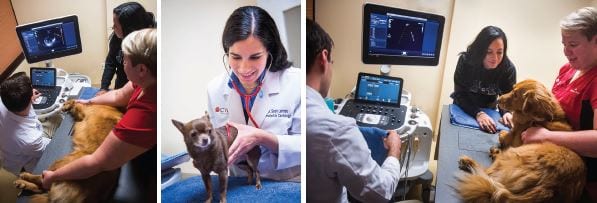What You Need to Understand About Veterinary Solutions: An Introduction of Diagnostic Devices and Procedures
Veterinary solutions play a crucial function in keeping the wellness of animals. Regular check-ups can expose hidden wellness concerns at an early stage. Different analysis tools and treatments, such as blood examinations and imaging methods, provide crucial insights right into an animal's wellness. Understanding these methods is essential for animal proprietors. What particular analysis procedures are most commonly utilized, and exactly how can they influence a family pet's therapy plan?
Value of Normal Veterinary Examinations
While lots of animal owners might undervalue the value of regular veterinary examinations, these consultations are vital for preserving an animal's total wellness. Routine sees to the veterinarian enable for very early discovery of potential wellness issues before they intensify right into serious issues. Routine examinations often consist of inoculations, which are necessary for avoiding infectious illness that can significantly affect a family pet's well-being. In addition, these consultations give an opportunity for vets to assess the animal's weight, dental wellness, and total condition, making sure that the pet is flourishing. During these check outs, pet dog proprietors can likewise get important advice on diet plan, exercise, and preventive treatment customized to their details family pet's requirements.
Typical Diagnostic Treatments in Vet Medication
In veterinary medicine, exact medical diagnosis is essential for reliable therapy. Typical analysis treatments consist of blood testing strategies, progressed imaging innovations, and urinalysis, each playing a considerable role in recognizing health problems. Comprehending these methods boosts the capability to provide appropriate care for pet clients.
Blood Testing Techniques
Blood screening techniques act as necessary diagnostic devices in veterinary medication, allowing veterinarians to analyze the health and wellness of pets accurately. These strategies entail gathering blood samples to assess different parts, such as red and white blood cells, platelets, and biochemical pens. Common examinations include total blood counts (CBC), which examine overall health and detect infections, and biochemical panels, which examine body organ feature and metabolic status. Furthermore, serological tests can determine particular illness via antibody discovery. Blood screening is minimally invasive and supplies essential details that aids in detecting conditions, checking health condition, and evaluating feedbacks to therapies. In general, these strategies play an important role in making sure ideal take care of animals and livestock alike.
Imaging Technologies Utilized
Diagnostic imaging modern technologies are essential tools in veterinary medication, enhancing blood screening techniques by offering aesthetic insights into a pet's internal frameworks. Usual imaging modalities include X-rays, which serve for assessing bone cracks and identifying foreign things, and ultrasound, which permits real-time visualization of soft cells and body organs. Magnetic vibration imaging (MRI) offers thorough photos of complicated anatomical areas, especially in neurological evaluations. Computed tomography (CT) supplies cross-sectional pictures, improving analysis precision for different conditions. Each of these innovations help veterinarians in identifying ailments, planning therapies, and keeping track of recuperation. By incorporating imaging technologies, veterinary professionals can better assess a pet's wellness and make educated choices concerning their care.
Urinalysis and Diagnostics
Urinalysis acts as a crucial analysis device in vet medication, supplying valuable insights right into an animal's overall health and aiding in the discovery of various conditions. This non-invasive treatment examines pee examples to assess kidney feature, hydration condition, and metabolic disorders. Usual parts checked out consist of particular gravity, pH degrees, sugar, healthy proteins, and the existence of blood or bacteria. Irregular findings can show problems such as urinary system tract infections, diabetic issues mellitus, or kidney illness. To enhance diagnostic accuracy, urinalysis is frequently executed in combination with other examinations, such as blood work and imaging research studies. Early detection via urinalysis can result in timely treatments, enhancing the prognosis for many vet individuals. Consequently, it is a necessary aspect of complete veterinary care.
Comprehending Blood Examinations and Laboratory Evaluation
Recognizing blood examinations and lab evaluation is vital in veterinary medicine as it assists in diagnosing different health and wellness problems in pets. Various types of blood tests give important details about an animal's interior state, while analyzing laboratory results calls for careful consideration of many variables. This area will explore the sorts of blood tests offered and the value of their outcomes.
Kinds Of Blood Tests
Blood examinations play an important role in veterinary medicine, supplying important insights into an animal's health and wellness standing. Numerous kinds of blood examinations are made use of, each serving different purposes. Complete blood counts (CBC) analyze overall health and spot conditions such as anemia or infection. Biochemical profiles assess organ feature by determining electrolytes and enzymes, supplying insights into metabolic wellness. Serological examinations recognize certain antibodies or pathogens, assisting in the diagnosis of infections or autoimmune illness. Blood inputting warranties safe transfusions, while coagulation examinations gauge the blood's capacity to clot, important for surgeries. These examinations collectively enhance diagnosis, therapy preparation, and monitoring of a pet's wellness, showing the value of extensive lab analysis in veterinary treatment.

Translating Laboratory Results
A thorough analysis of lab results is essential for precise medical diagnosis and therapy in vet medication. Interpreting laboratory results calls for an understanding of regular reference varieties and the importance of inconsistencies. Blood examinations can reveal various health and wellness indications, such as body organ feature, electrolyte equilibrium, and the presence of infections. Vets must think about the entire scientific photo, consisting of the animal's history, physical exam searchings for, and any symptoms provided. Variants in outcomes may emerge from variables such as age, type, and underlying wellness conditions. As a result, laboratory results ought to not be seen in seclusion yet instead as part of a comprehensive analysis click this approach. Precise interpretation permits customized therapy strategies and better results for veterinary people.
Imaging Techniques: X-rays, Ultrasounds, and Beyond
Imaging techniques are vital tools in vet medication, offering vital insights right into the health and wellness and well-being of pets. Among one of the most frequently utilized approaches are Ultrasounds and x-rays. X-rays are invaluable for envisioning bone frameworks, helping vets determine fractures, lumps, or foreign objects. This approach is non-invasive and fast, making it ideal for immediate situations.Ultrasounds, on the other hand, use sound waves to develop photos of soft cells and organs. This technique is particularly beneficial for taking a look at the heart, abdomen, and reproductive body organs, allowing vets to examine conditions like liquid buildup or body organ abnormalities.Beyond X-rays and ultrasounds, advanced imaging methods such as computed tomography (CT) and magnetic vibration imaging (MRI) are progressively utilized in veterinary technique. These techniques supply in-depth cross-sectional photos, boosting the accuracy of medical diagnoses and therapy plans. Ultrasound For Dogs. In general, imaging strategies play an important function in making certain efficient vet care
The Function of Biopsies in Diagnosing Pet Dog Health Issues
Accuracy in diagnosing health problems in pet dogs usually depends upon the use of biopsies, which supply clear-cut information regarding cells abnormalities. A biopsy involves the removal of a small sample of tissue for assessment under a microscopic lense, permitting vets to recognize various conditions, including infections, tumors, and inflammatory conditions. This diagnostic tool is vital for comparing benign and deadly developments, leading therapy choices, and evaluating the severity of a condition.Biopsies can be performed using various strategies, such as needle goal, incisional biopsies, or excisional biopsies, depending on the location and sort of cells included. The choice of approach might affect healing time and the amount of cells gathered. Inevitably, the information amassed from a biopsy can bring about targeted treatments, improving results for animals facing serious wellness challenges. Vets stress the relevance of this treatment in attaining exact medical diagnoses and efficient treatment strategies.
Advanced Diagnostic Equipment: Endoscopy and CT Checks

Advanced diagnostic tools, such as endoscopy and CT scans, play a crucial role in modern vet medication, supplying non-invasive techniques to envision interior structures and identify numerous conditions in pet dogs. Endoscopy entails the use of an adaptable tube geared up with an electronic camera, allowing vets to analyze the stomach tract and breathing system straight. This technique can disclose abnormalities such as growths, international bodies, or swelling, allowing targeted treatment plans.CT scans, on the various other hand, use advanced imaging innovation to produce thorough cross-sectional pictures of the body (CT Scans For Dogs). This approach is especially useful for examining complicated frameworks like the brain, spinal column, and joints. By supplying high-resolution photos, CT scans aid veterinarians in identifying issues that might not be evident via traditional radiography. Together, these sophisticated devices boost diagnostic accuracy, boost treatment end results, and eventually add to much better total animal health and wellness monitoring

Translating Test Outcomes: What Family Pet Owners Ought To Know
Understanding test outcomes can be a tough job for pet owners, particularly after advanced treatments like endoscopy and CT scans have been carried out. Interpreting these outcomes calls for a imp source grasp of medical terminology and a clear understanding of what the searchings for indicate concerning the animal's health. Veterinarians typically supply explanations, but the intricacy of the results can still result in confusion.Pet proprietors need to proactively take part in discussions with their vets, asking concerns to clarify any type of unpredictabilities. It is necessary to comprehend irregular versus typical outcomes and the ramifications for the pet dog's treatment plan. Furthermore, acknowledging that some results might call for more screening or surveillance can assist owners stay notified regarding their pet's health journey. Inevitably, a collective technique in between family pet proprietors and veterinary specialists cultivates have a peek at these guys far better wellness end results and boosts the overall care experience for pet dogs.
Regularly Asked Concerns
How Do I Choose the Right Vet Center for My Animal?
Choosing the best vet clinic entails investigating neighborhood options, reviewing certifications, going to facilities, and evaluating personnel interactions (Board Certified Veterinary Cardiologist). Focusing on referrals from trusted resources can assist guarantee the finest treatment and setting for a pet's wellness requirements
What Should I Do if My Animal Rejects to Go to the Vet?
When a pet rejects to head to the veterinarian, it's a good idea to continue to be tranquil, use deals with or toys to lure them, and consider arranging a home check out if anxiousness persists. Persistence and positive reinforcement are vital.
Are There Telehealth Options for Vet Services?
Telehealth alternatives for veterinary solutions are increasingly offered, allowing animal owners to talk to vets remotely. These services allow conversations regarding health issues, guidance on minor conditions, and follow-ups without needing to visit a clinic.
How Typically Should My Family Pet Have Dental Examinations?
The frequency of oral exams for animals typically relies on their age and breed. Generally, vets recommend yearly dental examinations, although some animals may need more frequent brows through to keep ideal oral wellness.

What Are the Expenses Related To Vet Diagnostics?
The costs connected with veterinary diagnostics can vary widely, normally varying from fundamental tests like blood work to advanced imaging techniques. Factors influencing costs consist of the facility's area, tools used, and details examinations needed for each and every family pet. Veterinary solutions play a crucial function in maintaining the wellness of family pets. While lots of pet owners might underestimate the value of routine veterinary exams, these visits are essential for maintaining an animal's general health. In addition, these appointments supply an opportunity for veterinarians to evaluate the animal's weight, oral health, and total condition, making sure that the family pet is growing. Precision in detecting health and wellness concerns in family pets frequently pivots on the usage of biopsies, which give definitive details regarding tissue problems. Additionally, acknowledging that some results might call for additional testing or surveillance can help proprietors stay educated concerning their pet's health trip.